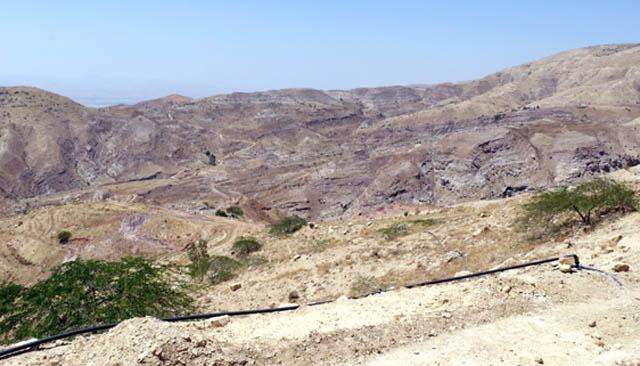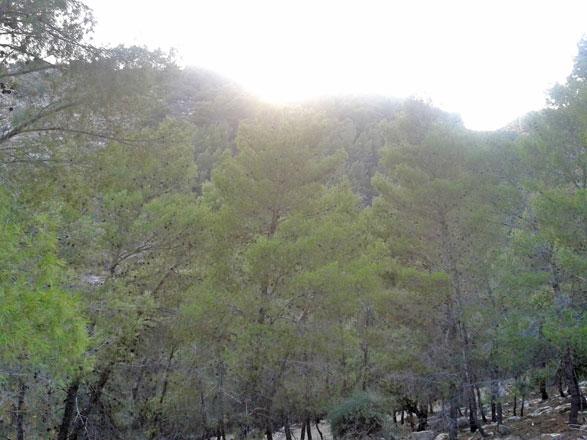You are here
Destroyed part of Dibben forest to be rehabilitated in two weeks
By Hana Namrouqa - Mar 04,2018 - Last updated at Mar 04,2018

A plot of Dibbeen forest that suffered illegal logging and wildfires over the past decade (Dibeen Association for Environmental Development)
AMMAN — In two weeks from now, a 15-dunum plot of land which suffered illegal logging and wildfires over the past decade, rendering it bare, is scheduled to be rehabilitated back to its once-thick forest status, conservationists said on Saturday.
The vacant tract, except for trunks of chopped and dried out burned trees, is part of a series of green hills that constitute Jerash Governorate’s Dibbeen forest, which represents the world’s last remaining southeastern community of Aleppo pines.
“This particular piece of land within Dibbeen forest is close to the main street. It was full of beautiful forest trees but witnessed over the past few years illegal logging and wild fires, leaving it completely bare except for shrubs,” Hala Murad, president of Dibeen Association for Environmental Development told The Jordan Times.
Under the project “NGOs alliance for the rehabilitation of forests”, NGOs in Jerash will participate in the rehabilitation of that piece of land.
“Some 700 indigenous forest trees will be planted in this plot of land by March 21, which is internationally celebrated as the International Day of Forests,” Murad noted.
The project does not only entail planting new forest trees, but also raising awareness of local communities and forest visitors alike on the importance of safeguarding forests, as they sustain Jordan’s biodiversity and are a major component in the fight against global warming.
Native forest trees to the area of Dibbeen will be planted, such as pine, maple and Greek juniper.
Previous attempts to revive this part of Dibbeen forest failed, according to head of Jerash forestry directorate, Abdul Hafeth Abu Urabi.
“There have been recent attempts to afforest this piece of land in particular, but the trees dried out eventually due to the lack of rain,” Abu Urabi said.
He underlined that any afforestation project needs to consider the irrigation element as a necessity to ensure the success of the replantation of trees.
“It will be different this time, there will be following up to sustain our efforts,” Abu Urabi said, noting that the Ministry of Agriculture is a partner in the project.
Murad highlighted that, to sustain the project, an irrigation system will be installed to water the trees, highlighting that, due to changing climate, Jordan is receiving less precipitation which is affecting forests’ survival.
Tree trunks and dried out and burned trees will be removed from the land, which will be fenced off to protect it against violators, according to Murad.
“We have a plan in mind to turn this part of the site from a degraded land to a sustainable forest, where picnickers can enjoy the surrounding area and the beautiful sceneries it opens to,” she underlined.
Noting that the project is funded by the Global Environment Fund, Murad said that the UNDP is also a partner.
“This project will be the stepping stone for a new kind of forest rehabilitation in Jordan; rehabilitation that is also sustained,” Murad noted.
Located some 48km north of Amman, the Dibbeen forest is the driest place in the world in which Aleppo pines grow naturally, with an average rainfall of around 400 millimetres per year, according to the Royal Society for the Conservation of Nature.
The Dibbeen forest is home to at least 17 threatened species, including the Persian squirrel, in addition to over a quarter of the butterfly species that exist in the Kingdom. It extends over 8.5 square kilometres of mountainous topography, rich with pine and oak trees.
Forests in Jordan constitute less than 1 per cent of the country’s total area of 89,342 square kilometres, making the Kingdom among the poorest countries worldwide in terms of forest cover, since the internationally accepted average of land covered by forests stands at 15 per cent of the total area.
Forestry land amount to 1.5 million dunums, of which 250,000 dunums are bare, 400,000 dunums are natural forests, 500,000 dunums are planted forests and 350,000 are nature reserves, according to official figures.
Related Articles
AMMAN — A vegetation report on a 20-dunum plot of land which suffered illegal logging and wildfires over the past decade, indicated that its
AMMAN — Progress on a project to plant 1,000 dunums in Balqa Governorate with trees to expand the green cover has reached 50 per cent, accor
AMMAN — Violations against forests in 2016 dropped by 70 per cent compared to previous years, Raed Adwan, the head of the forestry departmen


















